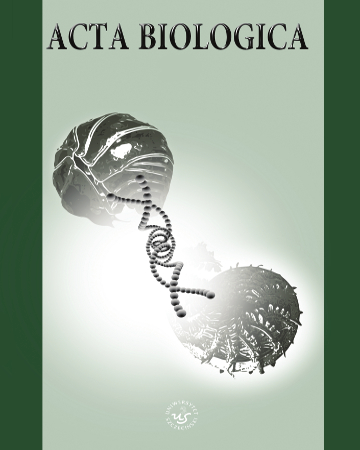
ISSN: 2450-8330
eISSN: 2353-3013
OAI
DOI: 10.18276/ab.2020.27-04



Issue archive /
No. 27
Species composition and diversity of morphotypes in epilithic biotopes of Zhytomyr region, Ukraine
| Authors: |
Marina
Patsyuk

Zhytomyr Ivan Franko State University, Vel. Berdychivska st., 40, Zhytomyr, 10008 Ukraine |
| Keywords: | naked amoebae morphotypes epilithic biotopes Zhytomyr region |
| Data publikacji całości: | 2020 |
| Page range: | 11 (31-41) |
Abstract
16 species of naked amoebae are recorded in the eplithic biotopes of Zhytomyr region, Ukraine:
Saccamoeba sp. (1), Saccamoeba sp. (2), Saccamoeba sp. (3), Cashia limacoides Page, 1974, Thecamoeba striata (Penard, 1890) Schaeffer, 1926, Thecamoeba sp., Stenamoeba stenopodia (Page, 1969) Smirnov et al., 2007, Mayorella cantabrigiensis Page, 1983, Mayorella sp., Korotnevella sp., Vexillifera sp., Vannella sp., Ripella platypodia Smirnov, Nassonova, Chao et Cavalier-Smith, 2007, Acanthamoeba sp. (1), Cochliopodium sp., Vahlkampfia sp. (1). The frequency of occurrence in samples is highest for Thecamoeba sp., Mayorella sp., Vahlkampfia sp. (1), Korotnevella sp., Vannella sp., and is lowest for Saccamoeba sp. (1), C. limacoides, M. cantabrigiensis, Cochliopodium sp., S. stenopodia, R. platypodia, T. striata, Saccamoeba sp. (2). The species and morphotype diversity of naked amoebae of the epilithic mosses and lichens is influenced by the humidity and the height above soil of the substrate. The species and morphotype diversity of naked amoebae decreases with the increase in height above soil and the decrease of humidity of substrate. We recorded naked amoebae of 9 morphotypes: monotactic, dactylopodial, fan-shaped, lens-like, lingulate, mayorellian, striate, acanthopodial, and eruptive. Amoebae of the lens-like and fan-shaped morphotypes disappear with the increase of height of substrate above soil.
Download file
Article file
Bibliography
| 1. | Adl, S.M., Bass, D., Lane, C.E. et al. (2019). Revisions to the Classification, Nomenclature, and Diversity of |
| 2. | Eukaryotes. Journal of Eukaryotic Microbiology, 66, 4–119. |
| 3. | Bonnet, L. (1973). Le peuplement thecamoebien des mousses corticoles. Protistologica, 9, 319–338. |
| 4. | Hammer, O., Harper, D.A.T., Ryan, P.D. (2001). PAST: Palaeontological statistics software package for |
| 5. | education and data analysis. Palaeontol. electronica, 4 (1), 1–9. |
| 6. | Korganova, G.A. (2003). Adaptive morphological structures in evolution of soil testate amoebae (Protista, |
| 7. | Testacea). Zoologicheskii Zhurn., 82 (2), 197–214 [in Russian]. |
| 8. | Lindo, Z., Winchester, N., Didham, R. (2008). Nested patterns of community assembly in the colonisation of |
| 9. | artificial canopy habitats by oribatid mites. Oikos, 117, 1856–1864. |
| 10. | Miller, K., Wagner, R., Woods, S. (2007). Effect of gap harvesting on epiphytes and bark-dwelling arthropods in |
| 11. | the Acadian forest of central Maine. Can. J. For. Res., 37, 2175–2187. |
| 12. | Page, F.C. (1988). A New Key to Freshwater and Soil Gymnamoebea. Freshwater Biological Association, |
| 13. | Ambleside, Cumbria, UK, 122 p. |
| 14. | Page, F.C., Siemensma, F.J. (1991). Nackte Rhizopoda und Heliozoea (Protozoenfauna Band 2). Stuttgart, New |
| 15. | York: Gustav Fischer Verlag. |
| 16. | Patcyuk, M.K., Dovgal, I.V. (2012). Biotopic distribution of naked amoebes (Protista) in Ukrainian Polissya area. |
| 17. | Vestnik Zoologii, 46 (4), 355–360. |
| 18. | Patsyuk, M.K. (2014). Morphotypes in Naked Amoebas (Protista): Distribution in Water Bodies of Zhy-tomyr and |
| 19. | Volyn Polissia (Ukraine) and Possible Ecological Significance. Vestnik Zoologii, 48 (6), 547–552. |
| 20. | Patsyuk, M.K. (2015). Species of naked amoebae (Protista) new for the fauna of Ukraine. Vestnik Zoologii, 5 |
| 21. | (49), 387–392. |
| 22. | Patsyuk, M.K. (2016). New Finds of Naked Amoebae (Protista) in Water Reservoirs of Ukraine. Vestnik Zoologii, |
| 23. | 50 (4), 291–300. |
| 24. | Patsyuk, M. (2017). Parasitic amoebae found in water bodies of Ukraine. Experimental Parasitology, 183, 81–84. |
| 25. | Patsyuk, M.K. (2018). Peculiarities of the Spatial Distribution of Naked Amoebas in Sandy Bottom Sediments of a |
| 26. | Small River. Hydrobiological Journal, 54 (5), 102–111. |
| 27. | Patsyuk, M.K., Onyshchuk, I.P. (2019). Diversity and Distribution of Naked Amoebae in Water Bodies of Sumy |
| 28. | Region (Ukraine). Vestnik Zoologii, 53 (3), 177–186. |
| 29. | Patsyuk, M. (2019). Changed species composition of naked amoebae in soils of forest-and-steppe zone of |
| 30. | Ukraine. Acta Biologica, 26, 57–64. |
| 31. | Patsyuk, M. (2020). Diversity of Naked Amoebae in Soils of Forest Areas of Zhytomyr Region (Ukraine). Zootaxa, |
| 32. | 4743 (2), 257–265. |
| 33. | Schönborn, W. (1989). The topophenetic analysis as a method to elucidate the phylogeny of testate amebas |
| 34. | (Protozoa, Testacealobosia and Testaceafilosia). Arch. Protistenk, 37, 223–245. |
| 35. | Smirnov, A., Goodkov, A. (1999). An illustrated list of basic morphotypes of Gymnamoebae (Rhizopoda, |
| 36. | Lobosea). Protistology, 1, 20–29. |
| 37. | Smirnov, A. (2008). Amoebas, Lobose. In: M. Schaechter (ed.), Encyclopedia of Microbiology (pp. 558– 577). |
| 38. | Oxford: Elsevier. |
| 39. | Smirnov, A., Chao, E., Nassonova, E., Cavalier-Smith, T. (2011). A Revised Classification of Naked Lobose |
| 40. | Amoebae (Amoebozoa: Lobosa). Protist, 162, 545–570. |